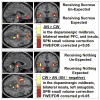Reward and neurocomputational processes
- PMID: 21243472
- PMCID: PMC3722417
- DOI: 10.1007/7854_2010_81
Reward and neurocomputational processes
Abstract
The neurobiology of eating disorders (EDs) is largely unknown. However, brain imaging studies over the past decade have identified neurotransmitter alterations that could be part of dysfunctional behavior characteristics of EDs. In this chapter we focus on a specific behavioral construct, the brain reward system, and demonstrate a functional brain imaging approach toward identifying dopamine function in anorexia nervosa (AN). We demonstrate how human brain reward activation can be used in a translational approach to test whether computer models, based on basic science research, can predict expected in vivo reward system activation, and how such an approach can identify specific biologic alterations in a psychiatric population.
Figures



Similar articles
-
Neurocircuity of eating disorders.Curr Top Behav Neurosci. 2011;6:37-57. doi: 10.1007/7854_2010_85. Curr Top Behav Neurosci. 2011. PMID: 21243469 Free PMC article. Review.
-
Altered brain reward circuits in eating disorders: chicken or egg?Curr Psychiatry Rep. 2013 Oct;15(10):396. doi: 10.1007/s11920-013-0396-x. Curr Psychiatry Rep. 2013. PMID: 23963630 Free PMC article. Review.
-
Advances from neuroimaging studies in eating disorders.CNS Spectr. 2015 Aug;20(4):391-400. doi: 10.1017/S1092852915000012. Epub 2015 Apr 23. CNS Spectr. 2015. PMID: 25902917 Free PMC article. Review.
-
Neuroimaging and eating disorders.Curr Opin Psychiatry. 2019 Nov;32(6):478-483. doi: 10.1097/YCO.0000000000000544. Curr Opin Psychiatry. 2019. PMID: 31306246 Free PMC article. Review.
-
Neuroendocrinology and brain imaging of reward in eating disorders: A possible key to the treatment of anorexia nervosa and bulimia nervosa.Prog Neuropsychopharmacol Biol Psychiatry. 2018 Jan 3;80(Pt B):132-142. doi: 10.1016/j.pnpbp.2017.02.020. Epub 2017 Mar 1. Prog Neuropsychopharmacol Biol Psychiatry. 2018. PMID: 28259721 Review.
Cited by
-
Toward valid and reliable brain imaging results in eating disorders.Int J Eat Disord. 2018 Mar;51(3):250-261. doi: 10.1002/eat.22829. Epub 2018 Feb 5. Int J Eat Disord. 2018. PMID: 29405338 Free PMC article.
-
The Role of Psychotropic Medications in the Management of Anorexia Nervosa: Rationale, Evidence and Future Prospects.CNS Drugs. 2016 May;30(5):419-42. doi: 10.1007/s40263-016-0335-6. CNS Drugs. 2016. PMID: 27106297 Free PMC article. Review.
-
Clinical Trials Required to Assess Potential Benefits and Side Effects of Treatment of Patients With Anorexia Nervosa With Recombinant Human Leptin.Front Psychol. 2019 May 17;10:769. doi: 10.3389/fpsyg.2019.00769. eCollection 2019. Front Psychol. 2019. PMID: 31156489 Free PMC article. Review.
-
A role for phasic dopamine release within the nucleus accumbens in encoding aversion: a review of the neurochemical literature.ACS Chem Neurosci. 2015 Jan 21;6(1):16-26. doi: 10.1021/cn500255p. Epub 2014 Dec 24. ACS Chem Neurosci. 2015. PMID: 25491156 Free PMC article. Review.
-
Reward-centricity and attenuated aversions: An adolescent phenotype emerging from studies in laboratory animals.Neurosci Biobehav Rev. 2016 Nov;70:121-134. doi: 10.1016/j.neubiorev.2016.08.015. Epub 2016 Aug 11. Neurosci Biobehav Rev. 2016. PMID: 27524639 Free PMC article. Review.
References
-
- Anderluh MB, Tchanturia K, et al. Childhood obsessive–compulsive personality traits in adult women with eating disorders: defining a broader eating disorder phenotype. Am J Psychiatry. 2003;160(2):242–247. - PubMed
-
- APA. Diagnostic & Statistical Manual of Mental Disorders: DSM–IV–TR. American Psychiatric Association; 2000.
-
- Apicella P, Ljungberg T, et al. Responses to reward in, monkey dorsal and ventral striatum. Exp Brain Res. 1991;85(3):491–500. - PubMed
-
- Bartoshuk LM, Beauchamp GK. Chemical senses. Annu Rev Psychol. 1994;45:419–449. - PubMed
-
- Bergh C, Sodersten P. Anorexia nervosa, self–starvation and the reward of stress. Nat Med. 1996;2(1):21–22. - PubMed
Publication types
MeSH terms
Grants and funding
LinkOut - more resources
Full Text Sources
Medical
Miscellaneous

